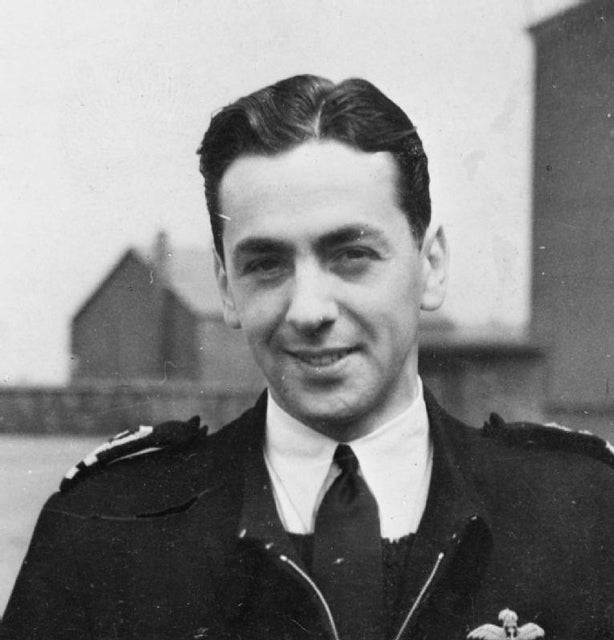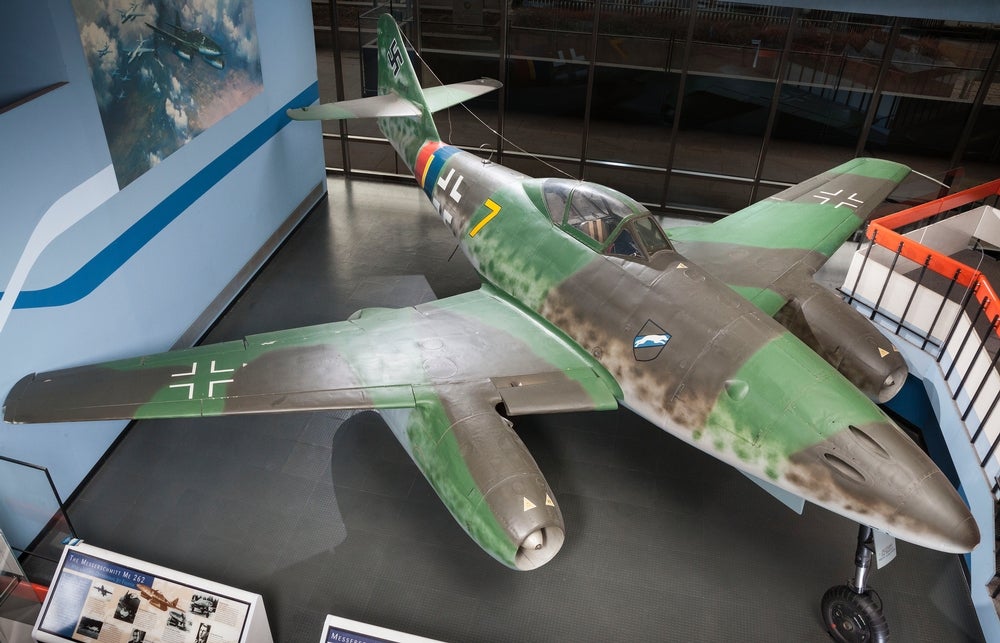HOT!
---------- Forwarded message ----------
From: AirSpace <noreply+feedproxy@google.com>
Date: Sat, Feb 27, 2016 at 6:26 PM
Subject: AirSpace
To: pascal.alter@gmail.com
From: AirSpace <noreply+feedproxy@google.com>
Date: Sat, Feb 27, 2016 at 6:26 PM
Subject: AirSpace
To: pascal.alter@gmail.com
AirSpace |
|
Posted: 27 Feb 2016 07:00 AM PST
A Tribute to British Royal Navy officer and experimental test pilot
I met Eric Brown in April 2013 at the Royal Air Force Club in Piccadilly, London. Enthusiastically, he had agreed to this meeting to answer my research questions. The first thing I noticed was how agile and slim he looked—barely 5 ft. 7 in. tall, he had the figure of a much younger man and walked the stairs up to the restaurant with the elegance and energy of a man much younger than the 94-year-old man he was at that time.Captain Eric Melrose "Winkle" Brown (27 January 1919 – 21 February 2016) While listening to him, I was aware that I talked to a true legend: the experimental test pilot who had flown 487 different types of aircraft, more than any pilot in history, and the British Royal Navy officer who had landed more aircraft on carriers than anybody else in the world, a total of 2,407 landings, among them even jet-propelled aircraft. Landing a plane on a pitching carrier in heavy seas, and especially under radio silence as enforced by the conditions of war, Brown once said was like landing on, "a matchbox floating in a bathtub," and, "a game of Russian roulette." Asked how he was able to fly so many wildly differing aircraft successfully, Eric responded that his secret was utmost concentration: "Learn her," he told a fellow pilot, "and then concentrate, concentrate, concentrate!"  Eric Brown as young Lieutenant Commander in the British Navy on December 3, 1945, when he first succeeded in landing a jet plane, the British DeHavilland Sea Vampire, on a British carrier, the HMS Ocean. Image: Imperial War Museum During his flying years, Brown experienced the transition from propeller to jet flight. As an experimental test pilot, he was at the forefront of this development. Brown was also a pilot of the Fleet Air Arm in the Battle of Britain, shooting down two German Focke-Wulf planes, and in December 1941, surviving the bombing and sinking of the British escort carrier Audacity. His special piloting skills were quickly recognized, and in 1942, he was posted to the Royal Aircraft establishment at Farnborough, a testing site for new aircraft. Here he served as an experimental test pilot and chief test pilot from 1944 to 1949. In 1942, he was decorated with a Distinguished Service Cross, followed by the appointment as Member of the Order of the British Empire in 1944, the Air Force Cross in 1947, and Commander of the Order of the British Empire in 1970. Brown was the most decorated pilot of the Fleet Air Arm and served in the early 1950s as resident British test pilot at the U.S. Navy's air test center at Patuxent River in Maryland. The California-based Society of Experimental Test Pilots made him an Honorary Fellow. Having been one of the first British pilots trained domestically on helicopters in the 1960s, Brown became director general of the British Helicopter Advisory Board in 1970, and later the vice president of the European Helicopter Association. In 1982, he was made president of the British Royal Aeronautical Society. His last prestigious award was the Founder's Medal of the British Air League in May 2015. The pilot's short size, he claimed, was a big advantage in his work especially during difficult landings, including the 11 plane crashes he survived. Taller pilots would have lost their lives, but Brown was able to simply curl his short legs beneath his seat, or pull his head down, preventing his neck from being broken. More importantly, Brown was never a cavalier pilot, kicking the tires and racing down the runway. Although he had an amazing power to improvise in difficult moments, he meticulously studied the aircraft he was asked to fly, paying close attention to detail—not only for the British planes he tested, but also axis aircraft from Germany, Japan, and Italy captured during World War II, as well as Soviet and American planes. Often, he interviewed the pilots who had flown these aircraft previously. Among them was German pilot Jörg "Czyp" Czypionka, who delivered his Messerschmitt Me 262 to Brown at the end of World War II. "It was my last flight in the 262, and it would be Brown's first," Czyp told me. After his flight, Eric had the highest praise for the 262, the world's first operational jet fighter, calling it, "the most formidable combat aircraft to evolve in World War II." Brown was also the only non-German pilot to take a powered flight in the Me 163 Komet. The Me 163 was a revolutionary aircraft with an unrivaled performance for its time, flying up to 1,127 kilometers per hour (700 miles per hour) and taking its pilots to the edge of the stratosphere. Driven by a volatile mix of two fuel components, Me 163s killed more pilots during fueling, starting, and landing than in actual combat. Before climbing into this explosive vehicle, Brown interviewed a number of Me 163 pilots, fully aware that, "there was so much to get wrong and virtually no escape route." But that didn't stop him from gaining experience on the Komet. Czyp said Brown "was an outstanding pilot, fearless, but when he flew an aircraft he always concentrated and was aware of the character of the aircraft and the task. This is the secret of his success, and his Guardian Angel." Over the years, a friendship would develop between Czyp and Brown—the British aviator fondly remembering the young German pilot when he met him many years later. Indeed, Brown was deeply respected and beloved among his colleagues: At his 97th birthday celebration in London, just one month ago, he was joined by more than 100 pilots from all over the world. Eric talked extensively about his experiences, publishing nine books and a truly fascinating series of articles under the title Viewed from the Cockpit. He kept his keen interest in aviation up to the last days of his life; lecturing, writing, patiently and openly talking to fellow pilots, aviation enthusiasts, and even researchers like me. In the late 1980s and 2000, he visited the National Air and Space Museum and talked about his amazing career in aviation. Brown was not only a witness to the incredible development in aviation technology since the 1940s, he was also a true witness to history, as I noticed that April day at the Royal Air Force Club. He deeply loved Germany and took great interest in the country, its politics, and people. Brown's father had been a pilot in the Royal Flying Corps in World War I, fighting the Germans in the air. In 1936, Brown traveled with his father to Berlin to attend a meeting of British and German fighter pilots. There, he met German flying aces of World War I like Herman Goering, then head of the German Luftwaffe, and Ernst Udet, then Luftwaffe's director-general of equipment. As he told me, it was the latter that suggested he learn to fly, and it was these early encounters in Germany that inspired him to learn German and to develop a deep interest in the country. Brown was in Germany when World War II started on September 1, 1939, and he was back in Germany when the war ended in May 1945. His knowledge of the German language, and his acquaintance with leading personalities of the Third Reich, put him in a unique position: Brown was not only the leading British test pilot for captured German aircraft, he was also the leading expert to interview and interrogate important German aviation personalities: rocket designer Wernher von Braun, aircraft designers and manufacturers Ernst Heinkel, Willy Messerschmitt, Kurt Tank, brothers Walter and Reimar Horten, test pilot Hanna Reitsch, as well as Luftwaffe General Robert Ritter von Greim. But he also interviewed personnel of the Bergen-Belsen concentration camp, where about 70,000 inmates had died between 1941 and 1945; half of them from typhus in the last months of the war and in the first weeks after its liberation by British troops in April 1945. Eric interrogated the camp commandant, Josef Kramer, and the female head guard, Irma Grese. When touring the camp, he wrote in his memoirs, "I saw for myself the piled dead, and the still open graves. I tried to speak to some of the silent, shuffling ghosts of men, in their striped rags. They would listen, staring dully at the ground, then step aside and move on. I had known the Germans, I had been happy in Germany. In the war I had made excuses for them, blamed the Nazis. There could be no excuse for this."  Bergen-Belsen concentration camp, April 1945. A British soldier talks to an emaciated camp inmate after the liberation. Image: Imperial War Museum "Winkle" was a humble and modest man, an unusual hero in the world of flying so often full of big egos blindly fixed on chasing the next record. Flying in the era of outstanding test pilots, during the 1940s and 1950s, Brown never achieved the celebrity status that was afforded to some of his contemporaries—he was not the first pilot to break the sound barrier, he never held a world air speed record, he never performed spectacular public stunts. Yet he was an astounding pilot, of extraordinary skill and versatility, with the perfect mix of courage and caution—one of the best pilots the world has ever seen. The quiet man with the diminutive height was a hero larger than life and a remarkable witness to history. He simply was "the right stuff." Many thanks to Jörg "Czyp" Czypionka for sharing his memories of Eric Brown with me. Evelyn Crellin is the curator for European Aviation in the Museum's Aeronautics Department The post Remembering Test Pilot Eric Melrose "Winkle" Brown appeared first on AirSpace. |
| You are subscribed to email updates from AirSpace. (....) | Email delivery powered by Google |
| Google Inc., 1600 Amphitheatre Parkway, Mountain View, CA 94043, United States | |





Brak komentarzy:
Prześlij komentarz